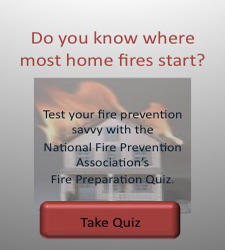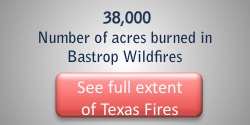When a wildfire breaks, sometimes families have only seconds to take action and protect themselves and their belongings. Taking the time to do some preparation work before the threat of an emergency can be key to reducing the likelihood of disasters and helping you be better equipped to handle a crisis.
Here are some helpful tips, compiled from organizations that are experts in handling emergencies.
         
|
1. Invest in homeowner’s insurance, update it periodically, and take an inventory of your property.
The Bastrop County wildfires rank as the costliest in Texas history with losses totaling $250 million, according to the Insurance Council of Texas. Bastrop residents and business owners have filed about 1,500 claims.
ICT recommends homeowners periodically evaluate what their insurance covers. As years go by, homeowners can become underinsured or have outdated policies.
Keeping an inventory of your possessions will make the claims process smoother, faster and ensure a fair settlement. The Insurance Information Institute recommends taking a video or photo inventory to make the process easier for you. Here’s how: www.KnowYourStuff.org
2. Create a family disaster plan.
You may not be with your family when disaster strikes, so discuss things like how you’ll stay in contact if separated. Every detail matters during an emergency situation. Here’s a checklist that will help start the conversation with your household. www.Ready.gov/America/MakeAPlan
3. Protect your income—financial planning for disasters.
How will you manage financially if you’re injured during a disaster or your employer has to shut down during a wildfire? Review your income options: www.RedCross.org/Preparedness/FinRecovery/FinPlan/
4. Keep wildfires in mind when constructing a home.
Think about design and landscape that can contain a fire, not fuel it. From fire resistant materials on the roof to treating wooden decks with fire-retardant chemicals, there are many options to ensure the fire safe construction of a home. Here’s a 20-minute National Fire Protection Association video that gives you a detailed checklist to consider:
5. Create a 30-50 foot safety zone around your home.
Do what you can to increase the space between your house and vegetation. FEMA recommends taking these precautions: www.FEMA.gov/Hazard/WildFire/Prepare
 6. Know what to do right before a fire approaches your house.
6. Know what to do right before a fire approaches your house.
If you have time before a fire comes your way, doing things like shutting off the gas can make a big difference. Find out what else you can do: www.FEMA.gov/Hazard/WildFire/Before
7. Talk to your neighbors about a wildfire safety plan.
Make a list of neighbors’ skills such as medical or technical. How could you help neighbors who have special needs or are elderly? Here’s how to get started: www.FireWise.org/Communities
8. Protect your records.
Organize important documents in a safe place. Here’s a checklist of vital records to store before a disaster: www.RedCross.org/Preparedness/FinRecovery/FinPlan/records.html
9. Protect your home.
Even if you’re not starting construction of a home, you can still help your existing home be safer against wildfires. Here’s how: www.FEMA.gov/Hazard/WildFire/Prepare
10. Have a Disaster Supplies Kit ready.
In case of a wildfire evacuation, the American Red Cross suggests you think about grabbing these before you leave home: www.RedCross.org/WildfireSafetyChecklist




